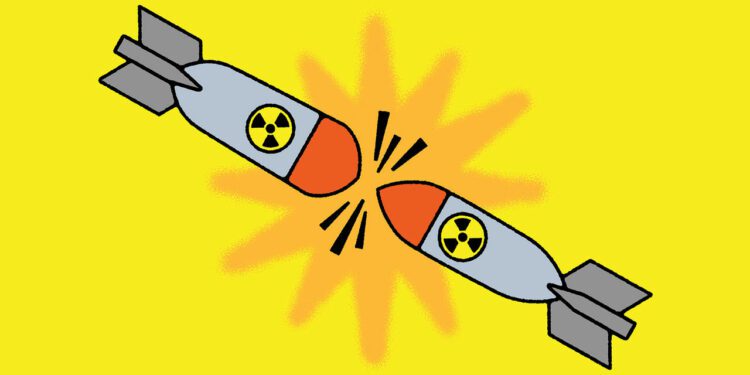IT IS BAD enough to contemplate a war in Asia. It is grimmer still to think through a nuclear one. But somebody has to. And so Andrew Metrick, Philip Sheers and Stacie Pettyjohn, all of the Centre for a New American Security (CNAS), a think-tank in Washington, recently gathered a group of experts to play a tabletop exercise—a type of wargame—to explore how a Sino-American nuclear war could break out. The results were not encouraging.
In the exercise scenario, it is 2032 and a war over Taiwan has been raging for 45 days. China uses “theatre” nuclear weapons—with a shorter range and smaller yield than the city-busting “strategic” missiles—to shorten the war by coercing America into submission. The targets include Guam and Kwajalein Atoll—a pair of islands vital to America’s military position in the Pacific—as well as an American aircraft-carrier strike group.
That is distressingly plausible. One reason is the geography of the Asian battlefield. During the cold war America and the Soviet Union both planned to use lots of tactical nuclear weapons to destroy large and dispersed troop formations, often in the vicinity of towns and cities. “Today in the Pacific”, notes the study, “naval vessels at sea and military airbases on small islands are a vastly different target.” Fewer nukes would be required and there would be less civilian harm than in cold-war strikes.
That is related to a second reason: the evolution of weaponry. Most people, not unreasonably, think of conventional weapons as being less escalatory and thus more usable than nuclear ones. But today’s low-yield nukes—20 kilotonnes of explosive power, roughly Hiroshima-size—can be delivered with extreme precision and less collateral damage. “The line between low-yield tactical nuclear weapons and precision-guided conventional weapons in terms of both their operational effects and perceived impact is blurring,” says CNAS.
The third factor is the effect of a long war. Weeks into a conflict, both sides would run short of conventional weapons. Theatre nuclear weapons would become more attractive. “On a per-weapon basis”, note the authors, “nuclear arms are more efficient at destroying large-area targets.” Their immense power means that they would also continue to work even if weeks of war had degraded the command, control and intelligence systems that conventional munitions rely on.
The result of all this, in the wargame, was a strange sort of nuclear war: China was incentivised to use nuclear weapons first, despite its formal “No First Use” pledge, but once it did so, and in contrast with expectations for how a US-Soviet war would have played out in Europe, things did not necessarily spiral into an apocalyptic exchange of strategic nuclear weapons. In the world of nuclear strategists, that is what counts as good news.
The exercises suggested China had more reason for cheer. The experts and officials playing as China had a wide range of military targets—Asia is chock-full of American facilities and naval assets. (Though there is little evidence that China possesses low-yield nukes right now.) The American team, by contrast, struggled with the fact that many of the most attractive targets for retaliation were on the Chinese mainland. Striking those with tactical nuclear weapons would carry a much higher risk of escalation to general nuclear war.
Moreover, the players found that America did not have the weapons needed to hit the “very small number” of lower-risk targets—mostly warships and Chinese bases on disputed reefs in the South China Sea. Its most advanced non-nuclear missiles would have run out by day 45. America, unlike Russia, no longer has a nuclear-tipped anti-ship missile. A new submarine-launched nuclear cruise missile is slated for the 2030s. But it could not be used for signalling to deter Chinese nuclear use before the fact without giving away where it was. It would also tie up scarce attack subs in the middle of a naval war.
Nuclear strategy has its own macabre grammar, steeped in the assumptions and experience of the cold war and reshaped by the march of military technology. It boils down to politics, though. Faced with the nuclear annihilation of 5,000 American sailors on a carrier or nuclear attack on American territory such as Guam, would an American president respond with nuclear force, reach for what would be a shrinking quiver of conventional weapons—or fold? That, concede the authors, is “the fundamental, unknowable component”.â–
Source link : http://www.bing.com/news/apiclick.aspx?ref=FexRss&aid=&tid=66d230b57794428d8de90bde971be668&url=https%3A%2F%2Fwww.economist.com%2Fasia%2F2024%2F08%2F22%2Fif-a-china-and-america-war-went-nuclear-who-would-win&c=12915762236774666452&mkt=en-us
Author :
Publish date : 2024-08-21 13:00:00
Copyright for syndicated content belongs to the linked Source.











